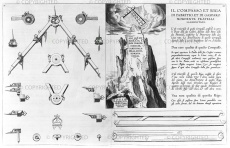Nine-Point Compasses
From Inventions
| Line 37: | Line 37: | ||
|strumentiesistenti= | |strumentiesistenti= | ||
| - | + | - Museo Galileo, Institute and Museum of the History of Science, Florence <br> | |
| - | [http:// | + | [http://catalogo.museogalileo.it/oggetto/CassettaStrumentiMatematici.html Florence, Museo Galileo. Istituto e Museo di Storia della Scienza, Inv. 2542.]<br /> |
| - | + | ||
| - | [http://emu.mhs.ox.ac.uk/Display.php?irn=1209 Oxford, Museum of the History of Science, | + | |
| + | - Museum of the History of Science, Oxford <br> | ||
| + | [http://emu.mhs.ox.ac.uk/Display.php?irn=1209 Oxford, Museum of the History of Science, inv. 49857.] | ||
| + | |||
| + | |||
| + | - Adler Planetarium, Chicago <br> | ||
| + | [http://www.adlerplanetarium.org/4dlink/4DACTION/webserveimage?M-67a Oxford, Museum of the History of Science, inv. M-67a.]<br> | ||
| + | |||
| + | |||
| + | Monaco, Deutsches Museum, inv. 63103.<br /> | ||
|link= | |link= | ||
Revision as of 14:01, 7 September 2010
Name documented by Michel Coignet ("neunspitziger passer") around 1608.
Contents |
Inventor
Fabrizio Mordente (1532-1608?)
Historic Period
1591
Description
Fifth version of the so-called "compasso magistrale" (masterly compasses) described by Fabrizio Mordente in a short pamphlet published in Antwerp in 1591, dedicated to Duke Alessandro Farnese: La Quadratura del Cerchio, la Scienza de' residui, il Compasso et Riga di Fabritio, et di Gasparo Mordente fratelli salernitani [The squaring of the circle, the science of residuals, the compass and rule by Fabrizio and Gasparo Mordente, Salernitan Brothers]. As compared to the previously described eight-point compasses, this version has an adjustable double point on one of the cursors, and was used with the parallel ruler developed by Gasparo Mordente. At the death of Alessandro Farnese, Mordente decided to return to Italy, more precisely to Rome, where he planned to meet Cristoforo Clavio, who had published years before a description of his method for measuring fractions of a degree: Fabbrica et usu instrumenti… [Fabrication and operation of instruments…] (Rome 1586). This last version of Mordente’s compasses was widely disseminated also thanks to Michel Coignet, who, starting from 1608, composed a whole treatise on the instrument in various languages. Written in Italian, the treatise was then translated into German with a title conferring on it the name of "nine-point compass": Neunspitziger passer. This was followed by a new extended version in Italian, it too promptly translated into German in Berlin in 1616: Beschreibung des passer Fabricij Mordenti. The work was then entrusted to a mathematician friend to be translated into French and published along with the pantometer also developed by Coignet, a publication that was postponed until 1626: La geometrie reduite en un facile et briefve pratique. In 1624, in Paris, a German soldier had also translated the text into Latin, mentioning that the compass was being sold at the price of 86 thalers. In 1626 the compass was described in the Centiloquium circini proportionum of Georg Galgemayr, but as the invention of an unknown author.
Bibliographical Resources
Bonelli, Maria Luisa. Di una bellissima edizione di Fabrizio Mordente Salernitano «Mathematico della Sacra Ces.a M.ta dell’Imperatore Rudolfo II», in «Physis», I, 1959, pp. 127-148.
Camerota, Filippo. Il Compasso di Fabrizio Mordente. Per la storia del compasso di proporzione, Firenze 2000
Coignet, Michel. Della forma, et parti del compasso di Fabritio Mordente Salernitano…, Anversa 1608.
Coignet, Michel. L’uso del compasso di Fabritio Mordente Salernitano..., ms. (Anversa 1608), Modena, Biblioteca Estense, Ms. Gamma U.1.18 (Campori 290).
Coignet, Michel. Beschreibung des Passers Fabricij Mordenti von Salerno…, ms. (Berlino 1616), Paris, Bibliothéque Nationale, Allemand 159.
Coignet, Michel. Neunspitziger Passer. Fabricii Mordenti von Salerno…, Wroclaw, Biblioteka Universythecka, Coll. Rehdigeriana 461.
Coignet, Michel. L’Uso del compasso di Fabricio Mordenti di salerno…, s.d., Madrid, Bibliotheca Nacional, MS 19.709/32.
Coignet, Michel. La geometrie reduite en un facile et briefve pratique; par… l’usage du compas a huict poinctes inventé par Fabrice Mordente etc., Parigi 1626.
Galgemayr, Georg. Centiloquium circini proportionum…, Nürnberg 1626.
Mordente, Fabrizio. La Quadratura del Cerchio, la Scienza de' residui, il Compasso et Riga di Fabritio, et di Gasparo Mordente fratelli salernitani, Anversa 1591 (copia manoscritta, Biblioteca Nazionale di Roma, Fondo Gesuitico 615).
Existing Instruments
- Museo Galileo, Institute and Museum of the History of Science, Florence
Florence, Museo Galileo. Istituto e Museo di Storia della Scienza, Inv. 2542.
- Museum of the History of Science, Oxford
Oxford, Museum of the History of Science, inv. 49857.
- Adler Planetarium, Chicago
Oxford, Museum of the History of Science, inv. M-67a.
Monaco, Deutsches Museum, inv. 63103.
Images
Author of the entry: Filippo Camerota

